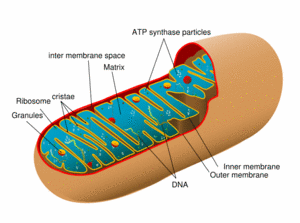What are Mitochondria?
The mitochondria are parts of every cell of the human body, except the red blood cells. They are responsible for processing oxygen and converting food into energy. This process accounts for over 90% of the energy the body uses to sustain life. Because of their presence in all cells containing genetic material, diseases and disorders of the mitochondria can follow an almost unlimited number of patterns and symptomologies. This article will attempt to simplify some of the more common patterns of mitochondrial diseases. It is important to note, however, that mitochondrial diseases can manifest themselves in a diverse number of ways. It is important to allow your physicians to help you to determine whether you are suffering from a mitochondrial disease.
What is Mitochondrial Disease?
At this time, there are over forty different recognized disorders that are identified as mitochondrial diseases. In people with mitochondrial disease, also known as metabolic disease, the mitochondria are unable to properly burn food and oxygen, and convert them into energy, due to an incomplete or inaccurate chemical reaction. As a result of this, improperly converted food matter converts into toxic matter in the body, affecting the other chemical reactions of the cells of the body, as well, causing cellular damage and death. Over time, the effects of mitochondrial disease can become so extensive in the cellular structure of the body that the damage caused by these defects is permanent. The effects of mitochondrial disease cover a wide spectrum, in terms of severity, and can be potentially devastating to the health of the person living with one of these disorders. The resulting illness can range in severity from mild to fatal.
The most common forms of mitochondrial disease seem to cause the most damage to the cells of the brain, heart, liver, skeletal muscles, kidney and the endocrine and respiratory systems. Depending on which cells are affected, symptoms may include loss of motor control, muscle weakness and pain, gastro-intestinal disorders and swallowing difficulties, poor growth, cardiac disease, liver disease, diabetes, respiratory complications, seizures, visual/hearing problems, lactic acidosis, developmental delays and susceptibility to infection. Mitochondrial diseases most commonly affect children, but adult onset of the symptoms of mitochondrial disease is becoming more frequent. However, as genetics, and understanding about the mitochondria, is a fairly new science, this increase in adult onset of mitochondrial disease may be due to better diagnosis of the classification of disorders. (The Cleveland Clinic, United Mitochondrial Disease Foundation)
Mitochondrial disease occurs in approximately 1 of 4,000 children by the age of ten years old.
What are the Symptoms of Mitochondrial Disease?
Mitochondrial disease affects the cells of the organ systems of the body. Depending on the particular disorder, one or multiple organ systems may be affected. The parts of the body that can come under attack by mitochondrial disease include the cells of the brain, nerves, muscles, kidneys, heart, liver, eyes, ears, and pancreas.
Depending on which cells of the body are affected, symptoms might include short stature and poor growth, loss of muscle coordination, muscle weakness, movement disorders, muscle twitching or jerking, neuropathy, encephalopathy (a condition of the brain that causes altered mental status among other complications), hearing problems, visual problems, ptosis (drooping of the eyelids), complicated migraine, stroke, heart disease, cardiac electrical conduction problems, liver disease, kidney disease, lactic acidosis (a build up of lactic acid in the body), gastrointestinal problems, constipation (often severe and chronic), respiratory disorders, diabetes, increased risk of infection, neurological problems, seizures, thyroid dysfunction, developmental delays, learning disabilities, developmental regression, mental retardation, and dementia. (The Cleveland Clinic, United Mitochondrial Disease Foundation)
Because these symptoms can be explained by any number of problems, the diagnosis of mitochondrial disease requires some problem solving. When these symptoms occur, but exhibit unexpected features, when multiple symptoms, or organ systems are involved, or when the symptoms continue to reoccur, often accompanied by infections, mitochondrial disease should be considered and investigated.
How is Mitochondrial Disease Diagnosed?
The first step toward diagnosing mitochondrial disease is through obtaining family history, performing complete physical and neurological workups, and by conducting non-invasive lab work, including the laboratory testing of blood and urine samples to check for obvious metabolic irregularities.
Should mitochondrial disease be suspected, but either not identified or not conclusive through the examination of the blood and urine, other testing may be required as well to obtain a diagnosis. The spinal fluid may be collected through a procedure called a lumbar puncture. Testing of the eyes (particularly the retinas, through the use of a retina scan called an electroretinography [ERG]), ears, heart (through an EKG), brain (through MRI). If necessary, more invasive tests may performed. Muscle biopsy, and collection of the fluid of the spine through a procedure called a lumbar puncture.
The use of DNA testing is also possible to diagnose mitochondrial disease. These tests are incredibly expensive, however, and are rarely covered by insurance under the current healthcare systems of the U.S. Physicians will generally attempt all other measures to diagnose or rule out mitochondrial disease before ordering DNA testing, and then only if it is considered necessary.
What Causes Mitochondrial Disease?
In most cases, mitochondrial disease is genetic in nature, and is inherited through the DNA. There are two types of DNA through which mitochondrial disease can be passed on, the DNA, and the mtDNA (mitochondrial DNA).
Mitochondrial disease is often inherited through the DNA. This is called autosomal inheritance. The transmission can be recessive or dominant. In recessive inheritance, typically no other family members are affected with the disorder. In dominant inheritance, other family members are often affected, and its inheritance in other siblings occurs at about 50%.
Mitochondrial disease is also inherited through MtDNA. This type is called MtDNA inheritance. MtDNA inherited mitochondrial disease is inherited from the mother, and its inheritance in other siblings occurs at about 100%.
Mitochondrial disease can also be acquired. There are a number of factors that can account for late onset mitochondrial disease, including toxicity from medications. Many causes of acquired mitochondrial disease are unknown. (The Cleveland Clinic)
What is Next for People with Mitochondrial Disease?
For those disgnosed with a mitochondrial disease, there is no cure. Treatment options are specific to the individual, depending on which organ systems are affected and how. No two people with mitochondrial disorder will be treated identically, or respond identically to treatment, due to the cellular nature of the disease. There is no standard treatment, and it is very important to remember that a metabolic specialist should determine a patient’s specific regime. Self-treating suspected mitochondrial disease may actually disrupt or destroy a doctor’s ability to properly diagnose the disease.
The treatment of mitochondrial disease will be specific to the symptomology of the patient. In most cases, the goal of treatment is to address the negative symptoms of the disease and to slow its progression in the body. Some common treatments include vitamin and enzyme therapies, and diet therapy. The use of antioxidants is also being investigated. It is considered beneficial for people with mitochondrial disease to avoid common toxins. Some of these toxins include alcohol, cigarette smoke, and MSG. Additionally, avoiding physiologic stress can be helpful in managing mitochondrial disease. Some of examples of physiologic stress include extremes in hot and cold temperatures and inadequate amounts of food and sleep. (United Mitochondrial Disease Foundation)
Unfortunately, there is no way to predict what path mitochondrial disease will follow. The metabolic, cellular nature of the disease makes it impossible to categorize it as a disease of any specific severity or as one that follows an identified timeline or affects that body in a predictable way. The prognosis of a person living with mitochondrial disease will be specific to the nature of their disease and the organ systems affected. Better information from a metabolic specialist is required to help a patient and his or her family to better understand the nature of the particular mitochondrial disease he or she is living with, and the best treatment options available.
Reference:
- The Cleveland Clinic



